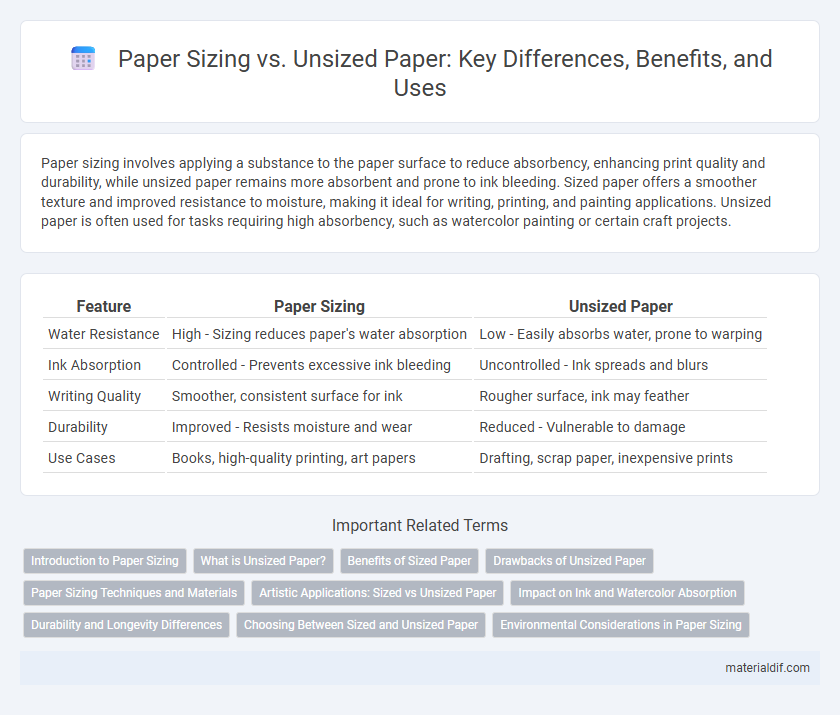Paper sizing involves applying a substance to the paper surface to reduce absorbency, enhancing print quality and durability, while unsized paper remains more absorbent and prone to ink bleeding. Sized paper offers a smoother texture and improved resistance to moisture, making it ideal for writing, printing, and painting applications. Unsized paper is often used for tasks requiring high absorbency, such as watercolor painting or certain craft projects.
Table of Comparison
| Feature | Paper Sizing | Unsized Paper |
|---|---|---|
| Water Resistance | High - Sizing reduces paper's water absorption | Low - Easily absorbs water, prone to warping |
| Ink Absorption | Controlled - Prevents excessive ink bleeding | Uncontrolled - Ink spreads and blurs |
| Writing Quality | Smoother, consistent surface for ink | Rougher surface, ink may feather |
| Durability | Improved - Resists moisture and wear | Reduced - Vulnerable to damage |
| Use Cases | Books, high-quality printing, art papers | Drafting, scrap paper, inexpensive prints |
Introduction to Paper Sizing
Paper sizing is a crucial process that enhances the surface strength and reduces the absorbency of paper, making it more suitable for writing and printing. Unsized paper lacks these treatments, resulting in increased ink absorption and lower durability. Understanding the differences between sized and unsized paper helps in selecting the appropriate type for specific printing or artistic applications.
What is Unsized Paper?
Unsized paper lacks any protective coating, making it highly absorbent and prone to bleeding or feathering when applied with ink or paint. This type of paper is often preferred for certain art techniques requiring extensive blending or water absorption, such as watercolor painting. Without sizing, the fibers remain open and untreated, resulting in a raw texture that impacts ink flow and paper durability.
Benefits of Sized Paper
Sized paper exhibits superior resistance to ink absorption, resulting in sharper images and clearer text compared to unsized paper. The sizing treatment enhances the paper's durability and reduces ink bleed-through, making it ideal for high-quality printing and writing applications. These properties contribute to increased longevity and preservation of documents printed on sized paper.
Drawbacks of Unsized Paper
Unsized paper lacks a protective coating, resulting in poor ink absorption and increased smudging during printing processes. This deficiency often causes ink to bleed and feather, leading to reduced print clarity and compromised image quality. Moreover, unsized paper is more susceptible to moisture, which can cause warping and deterioration over time.
Paper Sizing Techniques and Materials
Paper sizing enhances surface strength and reduces absorbency by applying materials such as starch, gelatin, or synthetic resins during the papermaking process. Internal sizing introduces these agents into the pulp, improving ink holdout and print quality, while surface sizing applies them after sheet formation to increase smoothness and durability. Common sizing techniques include the use of alkyl ketene dimer (AKD) and alkenyl succinic anhydride (ASA) for chemical sizing, along with traditional methods like rosin and alum to control paper porosity and performance characteristics.
Artistic Applications: Sized vs Unsized Paper
Sized paper features a surface coating that controls ink and paint absorption, providing enhanced durability and preventing excessive bleeding, which is essential for detailed artistic work like watercolor and ink drawing. Unsized paper absorbs liquids more freely, resulting in softer edges and potential feathering, often preferred for experimental techniques and textured effects in mixed media art. Artists selecting between sized and unsized paper consider factors such as medium control, paper texture, and the desired interaction of pigments with the surface.
Impact on Ink and Watercolor Absorption
Paper sizing significantly influences ink and watercolor absorption by creating a barrier that controls liquid penetration, resulting in sharper lines and vibrant colors on sized paper. Unsized paper absorbs ink and watercolor more readily, causing colors to spread and blend unpredictably, which can lead to less defined artwork. This difference affects drying times and the final texture, making sizing a crucial factor for artists seeking precision and color fidelity.
Durability and Longevity Differences
Sized paper exhibits enhanced durability and longevity due to its protective coatings that resist moisture absorption and reduce fiber deterioration, preserving the paper's structural integrity over time. Unsized paper lacks this protective layer, resulting in increased absorbency that causes faster degradation and reduced lifespan when exposed to environmental factors. The sizing process significantly improves paper's resistance to wear, making sized paper preferable for archival and durable printing purposes.
Choosing Between Sized and Unsized Paper
Choosing between sized and unsized paper depends on the intended use and desired durability; sized paper, treated with additives like rosin or starch, offers enhanced resistance to ink bleed and moisture, making it ideal for high-quality printing and archival purposes. Unsized paper, lacking these treatments, is more absorbent and suitable for applications requiring paint or adhesive absorption. Understanding the differences in surface strength and ink interaction helps in selecting the appropriate paper for specific artistic or printing needs.
Environmental Considerations in Paper Sizing
Paper sizing involves applying substances like rosin or synthetic agents to enhance paper's resistance to water and ink absorption, impacting recyclability and biodegradability. Unsized paper, lacking these treatments, generally offers better environmental performance with easier recycling and reduced chemical waste. Choosing unsized paper supports sustainable practices by minimizing chemical use and promoting eco-friendly disposal.
Paper Sizing vs Unsized Paper Infographic

 materialdif.com
materialdif.com